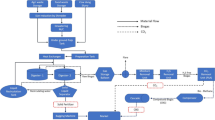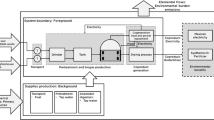Abstract
This article is a case study to compare the economic viabilities of biogas generation and compost projects in a palm oil mill in Malaysia with and without clean development mechanism (CDM). Biogas is captured from anaerobic ponds or digester tanks treating palm oil mill effluent (POME) and converted to green renewable electricity for grid connection, while compost is produced from the shredded empty fruit bunch and raw untreated POME. The both technologies were compared by considering the changes of the materials flow and energy balances. A palm oil mill with a capacity of 54 t fresh fruit bunch per hour has the potential to produce either 6.9 GWh of electricity from biogas or fertilizer equivalent to 488 t of nitrogen, 76 t of phosphorus and 1,065 t of potassium per year. The economic analysis for 10 years project term analysis indicated that CDM gave a significant impact and ensured economic viability for both projects with 25 % of internal rate of return (IRR), RM 12.39 million of net present value (NPV) and 3.5 years of payback period (PBP) for biogas project, whereas 31 % of IRR, RM 10.87 million of NPV and 2.9 years of PBP for compost project, respectively. In addition, sensitivity analysis indicated that the profitability of both projects will vary depending on the economic situation, such as electricity price which is based on the government policy, whereas compost price that depend on fertilizer market price with 43 % NPV change in 20 % range of fertilizer value.




Similar content being viewed by others
Notes
Commodity market prices are cited from online page, for example World Bank (www.worldbank.org).
CER credit price is cited in online page, for example ICE (https://www.theice.com/homepage.jhtml) and BlueNext (http://www.bluenext.eu/).
References
Ahmad, A. L., Ismail, S., & Bhatia, S. (2003). Water recycling from palm oil mill effluent (POME) using membrane technology. Desalination, 157, 87–95.
Baharuddin, A. S., Wakisaka, M., Shirai, Y., Abd-Aziz, S., Rahman, N. A. A., & Hassan, M. A. (2009). Co-composting of empty fruit bunches and partially treated palm oil palm mill effluents in pilot scale. International Journal of Agricultural Research, 4, 69–78.
Baharuddin, A. S., Hock, L. S., Yusof, M. Z., Rahman, N. A. A., Shah, U. K. M., Hassan, M. A., et al. (2010). Effects of palm oil mill effluent anaerobic sludge from 500 m3 of closed anaerobic methane digested tank on pressed-shredded empty fruit bunch (EFB) composting process. African Journal of Biotechnology, 9, 2427–2436.
Baharuddin, A. S., Rahman, N. A. A., Shah, U. K. M., Hassan, M. A., Wakisaka, M., & Shirai, Y. (2011). Evaluation of pressed shredded empty fruit bunch-palm oil mill effluent anaerobic sludge based compost using Fourier transform infrared and nuclear magnetic resonance analysis. African Journal of Biotechnology, 41, 8082–8089.
Hamdan, A. B., Tarmizi, A. B., & Tayeb, M. D. (1998). Empty fruit bunch mulching and nitrogen fertilizer amendment: The resultant effect on oil palm performance and soil properties. PORIM Bulletin Palm Oil Research Institute Malaysia, 37, 105–111.
Hassan, Z. A., Pin, O. K., Abdullah, Z., & Rahman, M. S. (2009a). The effect of EFB-compost application on oil palm under terrace planting. In Presented at the proceeding of the PIPOC 2009, international palm oil congress (agriculture, biotechnology, and sustainability) (pp. 603–614). Kuala Lumpur.
Hassan, M. A., Sulaiman, A., Shirai, Y., & Abd-Aziz, S. (2009b). Methane capture and clean development mechanism project for the sustainability of palm oil industry in Malaysia. Journal of Applied Science Research, 5, 1568–1581.
Hock, L. S., Baharuddin, A. S., Ahmad, M. N., Shah, U. K. M., Rahman, N. A. A., Abd-aziz, S., et al. (2009). Physicochemical changes in windrow co-composting process of oil palm mesocarp fiber and palm oil mill effluent anaerobic sludge. Australian Journal of Basic and Applied Sciences, 3, 2809–2816.
Lam, M. K., & Lee, K. T. (2011). Renewable and sustainable bioenergies production from palm oil mill effluent (POME): Win–win strategies toward better environmental protection. Biotechnology Advances, 29, 124–141.
Malaysia Energy Centre (PTM). (2004). Study on clean development mechanism potential in the waste sectors in Malaysia. Available at: http://cdm.unfccc.int/filestorage/E/Z/A/EZA3HTDQXJ0LSN9PCRK81F246IYWB5. Accessed on March 31, 2012.
Malaysian Palm Oil Board (MPOB). (2011). Available at: http://econ.mpob.gov.my. Accessed on August, 2011.
McCarthy, J. K., Raul, R., & Cardenas, J. (2006). Encyclopedia of environmental science and engineering (Chap. 13) composting. Available at: http://www.crcnetbase.com/doi/pdf/10.1201/NOE0849398438.ch13. Accessed on August 30, 2011.
Nordin, A. B. A., Simeh, M. A., Amiruddin, M. N., Weng, C. K. W, & Salam, B. A. (2004). Economic feasibility of organic palm oil production in Malaysia. Oil Palm Industry Economic Journal, 4, 29–38. Available at: http://ebookbrowse.com/economic-feasibility-of-organic-palm-oil-production-in-malaysia-pdf-d48184472. Accessed on September 20, 2011.
Oviasogie, P. O., Aisueni, N. O., & Brown, G. E. (2010). Oil palm composted biomass: A review of the preparation, utilization, handling and storage. African Journal of Agricultural Research, 5, 1553–1571.
Shirai, Y., Wakisaka, M., Yacob, S., Hassan, M. A., & Suzuki, S. (2003). Reduction of methane released from palm oil mill lagoon in Malaysia and its countermeasures. Mitigation and Adaptation Strategies for Global Change, 8, 237–252.
Singh, R. P., Ibrahim, M. H., Esa, N., & Iliyana, M. S. (2010). Composting of waste from palm oil mill: A sustainable waste management practice. Reviews in Environmental Science and Biotechnology, 9, 331–344.
Singh, R. P., Embrandiri, A., Ibrahim, M. H., & Esa, N. (2011). Management of biomass residues generated from palm oil mill: Vermicomposting a sustainable option. Resources, Conservation and Recycling, 55, 423–434.
Stichnothe, H., & Schuchardt, F. (2010). Comparison of different treatment options for palm oil production waste on a life cycle basis. The International Journal of Life Cycle Assessment, 15, 907–915.
Stichnothe, H., & Schuchardt, F. (2011). Life cycle assessment of two palm oil production systems. Biomass and Bioenergy, 35, 3976–3984.
Subramaniam, V., Ngan, M. A., May, C. Y., & Sulaiman, N. M. N. (2008). Environmental performance of the milling process of Malaysian palm oil using the life cycle assessment approach. American Journal of Environmental Sciences, 4, 310–315.
Suhaimi, M., & Ong, H. K. (2001). Composting empty fruit bunches of oil palm. Malaysian Agricultural Research and Development Institute (MARDI). Available at: http://www.agnet.org/library.php?func=view&id=20110804151206&type_id=4. Accessed on March 31, 2012.
Thambirajah, J. J., Zulkali, M. D., & Hashim, M. A. (1995). Microbiological and biochemical changes during the composting of oil palm empty-fruit-bunches. Effect of nitrogen supplementation on the substrate. Bioresource Technology, 52, 133–144.
The Performance Management and Delivery Unit (PEMANDU). (2010). Economic transformation programme a roadmap for Malaysia (Chap. 9, pp. 279–314). Palm oil.
Theng, F. S. (2006). An alternative system in waste management-integrated natural fertiliser plant. In Presented at the proceeding of the national seminar on palm oil milling, refining, technology, quality, and environment. MPOB national conference 2006 (pp. 228–232), Kuching.
United Nations Framework Convention on Climate Change (UNFCCC). (2006). Approved baseline and monitoring methodology AM0039: Methane emissions reduction from organic waste water and bioorganic solid waste using co-composting. Available at http://cdm.unfccc.int/EB/026/eb26_repan06.pdf. Accessed on August 1, 2011.
United Nations Framework Convention on Climate Change (UNFCCC). (2008a). Project design document (PDD): FELDA Serting Hilir biogas power plant project. Available at http://cdm.unfccc.int/UserManagement/FileStorage/8IRFMUX1SCQ64AHWPDKBT7320V5Y9Z. Accessed on July 15, 2011.
United Nations Framework Convention on Climate Change (UNFCCC). (2008b). Methodological tool: Tool for the demonstration and assessment of additionality. Available at http://cdm.unfccc.int/methodologies/PAmethodologies/tools/am-tool-01-v5.2.pdf. Accessed on July 20, 2011.
United Nations Framework Convention on Climate Change (UNFCCC). (2009). Project design document (PDD): Co-composting with AVC POME treatment system for Haranky palm oil mill. Available at http://cdm.unfccc.int/UserManagement/FileStorage/3HVPJ7XT5OMD4R9S6IZACL0G21YNFB. Accessed on August 1, 2011.
United Nations Framework Convention on Climate Change (UNFCCC). (2010). Project design document (PDD): Co-composting of EFB and POME at PT. Sabut Mas Abadi in Kumai. Available at http://cdm.unfccc.int/UserManagement/FileStorage/E490MYL7HXBGR1SNJTQZ6P28I3OVUA. Accessed on August 1, 2011.
Wu, T. Y., Mohammad, A. W., Jahim, J. M., & Anuar, N. (2009). A holistic approach to managing palm oil mill effluent (POME): Biotechnological advances in the sustainable reuse of POME. Biotechnology Advances, 27, 40–52.
Wu, T. Y., Mohammad, A. W., Jahim, J. M., & Anuar, N. (2010). Pollution control technologies for the treatment of palm oil mill effluent (POME) through end-of-pipe processes. Journal of Environmental Management, 91, 1467–1490.
Yacob, S., Hassan, M. A., Shirai, Y., Wakisaka, M., & Subash, S. (2005). Baseline study of methane emission from open digesting tanks of palm oil mill effluent treatment. Chemosphere, 59, 1575–1581.
Yacob, S., Shirai, Y., Hassan, M. A., Wakisaka, M., & Subash, S. (2006). Start-up operation of semi-commercial closed anaerobic digester for palm oil mill effluent treatment. Process Biochemistry, 41, 962–964.
Yeoh, B. G. (2004). A technical and economic analysis of heat and power generation from biomethanation of palm oil mill effluent. Electricity Supply Industry in Transition, 20, 63–78.
Yusoff, S. (2006). Renewable energy from palm oil—Innovation on effective utilization of waste. Journal of Cleaner Production, 14, 87–93.
Acknowledgments
This work was accomplished by obtaining technical and financial field data from Felda Serting Hilir Palm Oil Mil. We wish to gratefully acknowledge Felda Palm Industries Sdn Bhd (FPI) for this encouragement and permission to conduct research at the palm oil mill. This work was conducted under the financial support of Japan Society for the Promotion of Science (JSPS).
Author information
Authors and Affiliations
Corresponding author
Rights and permissions
About this article
Cite this article
Yoshizaki, T., Shirai, Y., Hassan, M.A. et al. Economic analysis of biogas and compost projects in a palm oil mill with clean development mechanism in Malaysia. Environ Dev Sustain 14, 1065–1079 (2012). https://doi.org/10.1007/s10668-012-9371-7
Received:
Accepted:
Published:
Issue Date:
DOI: https://doi.org/10.1007/s10668-012-9371-7




